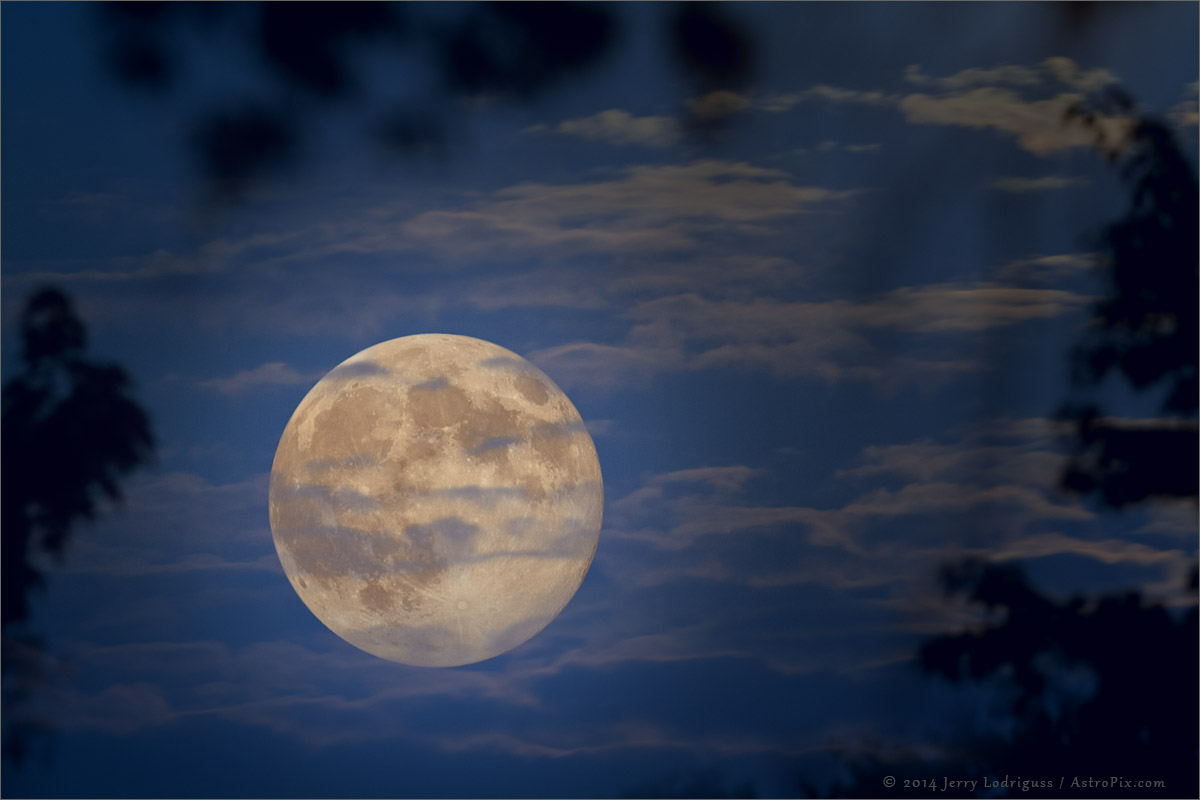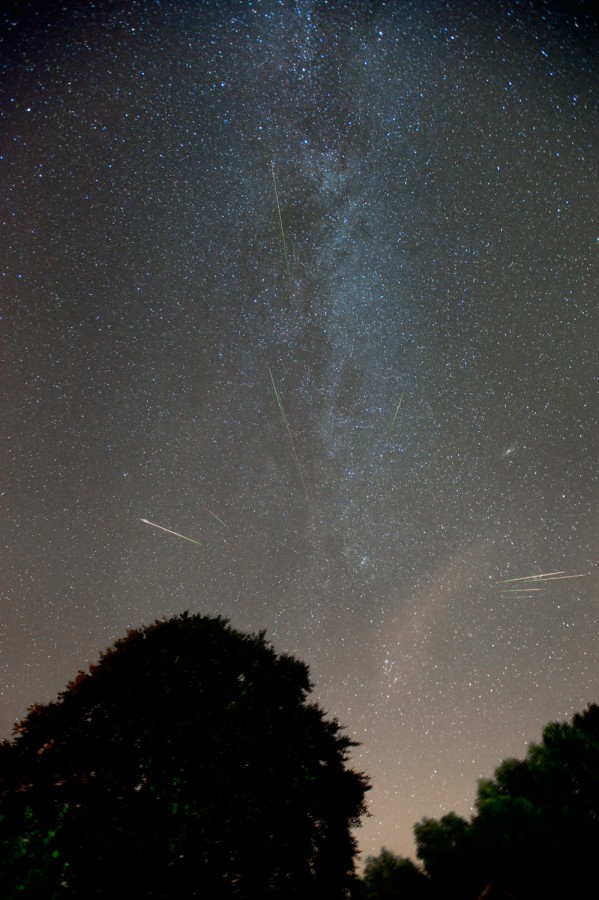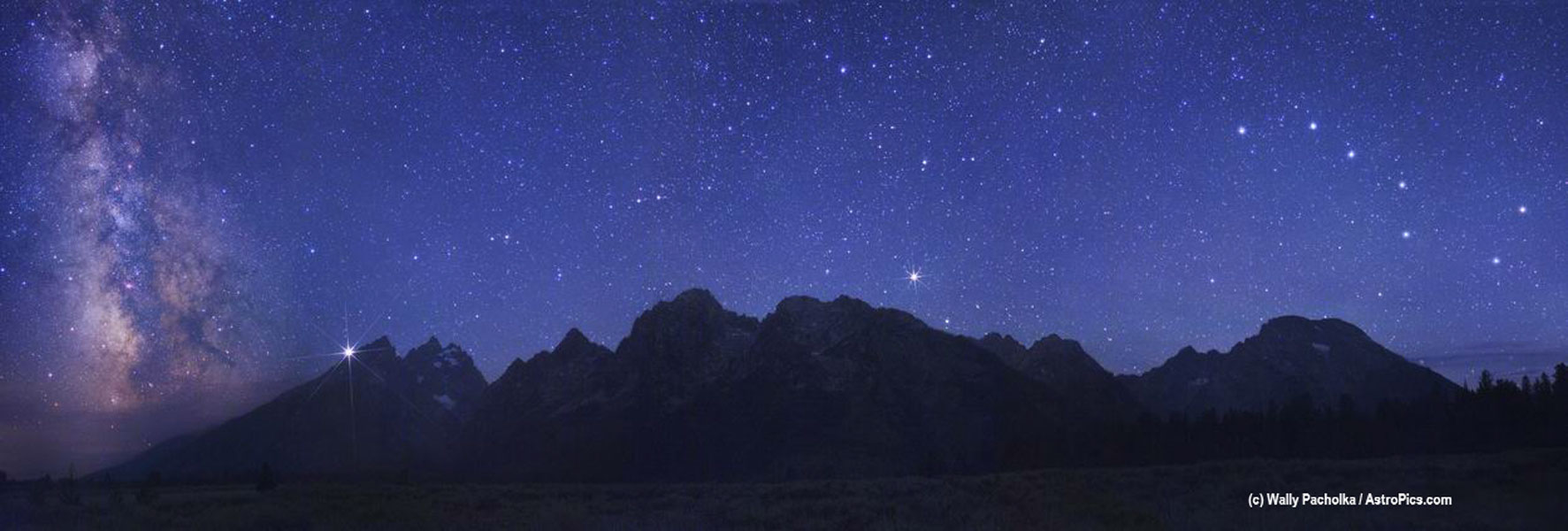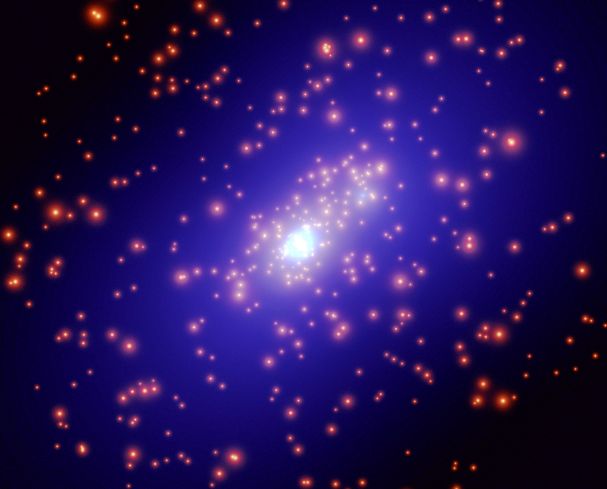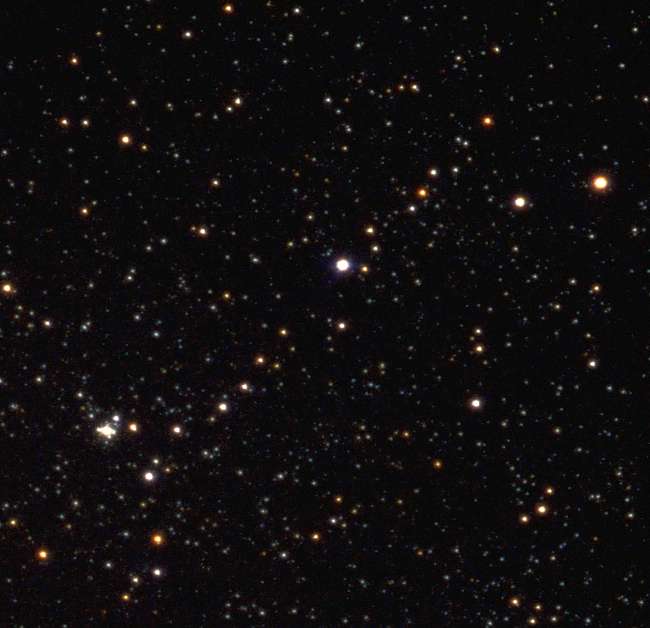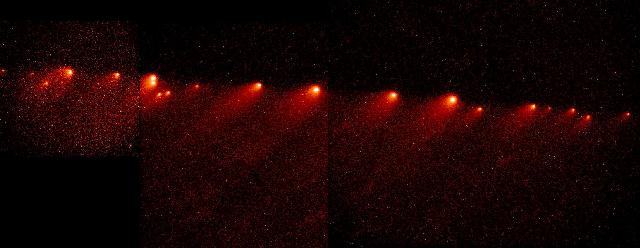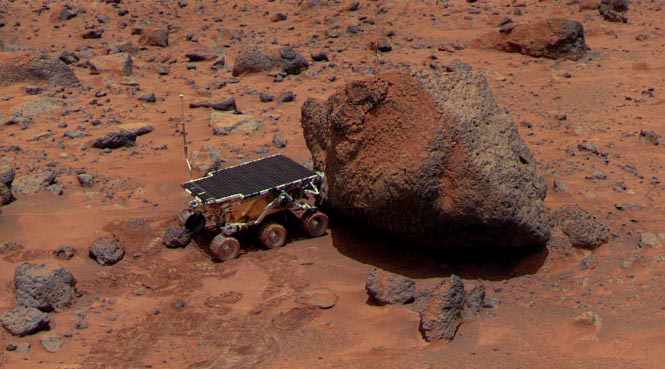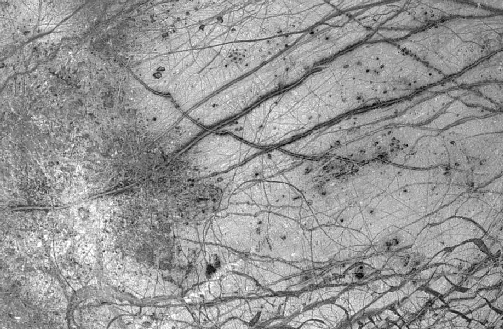| << Previous | Index | Next >> |
2015 Dusty debris from periodic Comet Swift-Tuttle was swept up by planet Earth this week. Vaporized by their passage through the dense atmosphere at 59 kilometers per second, the tiny grains produced a stream of Perseid meteors. A bright, colorful Perseid meteor flash was captured during this 20 second exposure. It made its ephemeral appearance after midnight on August 12, in the moonless skies over the broad granite dome of Enchanted Rock State Natural Area, central Texas, USA. Below the Perseid meteor, trees stand in silhouette against scattered lights along the horizon and the faint Milky Way, itself cut by dark clouds of interstellar dust.
2014 Big, bright, and beautiful, a Full Moon near perigee, the closest point in its elliptical orbit around our fair planet, rose on August 10. This remarkable picture records the scene with a dreamlike quality from the east coast of the United States. The picture is actually a composite of 10 digital frames made with exposures from 1/500th second to 1 second long, preserving contrast and detail over a much wider than normal range of brightness. At a perigee distance of a mere 356,896 kilometers, August's Full Moon was the closest, and so the largest and most super, of the three Full Moons nearest perigee in 2014 now popularly known as supermoons. But if you missed August's super supermoon, the next not-quite-so supermoon will be September 8. Then, near the full lunar phase the Moon's perigee will be a slightly more distant 358,387 kilometers. That's only about 0.4 percent less super (farther and smaller) than the super supermoon.
2013 It took three worlds to create this simple image. The first world was the Earth, which was quite prominent. The dividing line running horizontally below the middle separates sea from sky. On this part of the Earth, it was almost nighttime. The second world was the Moon, which was almost invisible. The Moon had its unilluminated half masked by the red sunset glow of Earth's sky. A thin sliver of the new Moon was visible, a crescent that traces the bright curving line. The third world was the Sun, which does not appear directly. All of the light recorded in the image originated from the Sun. The above half-second exposure was taken last week from Anping, Taiwan. A few minutes after this image was taken the Earth had spun just a little bit further -- forcing the Moon to follow the Sun into the sea -- and the horizon to become dark.
2012 Where will the next Perseid meteor appear? Sky enthusiasts who trekked outside for the Perseid meteor shower that peaked over the past few days typically had this question on their mind. Six meteors from this past weekend are visible in the above stacked image composite, including one bright fireball streaking along the band of the background Milky Way Galaxy. All Perseid meteors appear to come from the shower radiant in the constellation of Perseus. Early reports about this year's Perseids indicate that as many as 100 meteors per hour were visible from some dark locations during the peak. The above digital mosaic was taken near Weikersheim, Germany.
2011 The scene might have been considered serene if it weren't for the tornado. During 2004 in Kansas, storm chaser Eric Nguyen photographed this budding twister in a different light -- the light of a rainbow. Pictured above, a white tornado cloud descends from a dark storm cloud. The Sun, peeking through a clear patch of sky to the left, illuminates some buildings in the foreground. Sunlight reflects off raindrops to form a rainbow. By coincidence, the tornado appears to end right over the rainbow. Streaks in the image are hail being swept about by the high swirling winds. Over 1,000 tornadoes, the most violent type of storm known, occur on Earth every year, many in tornado alley. If you see a tornado while driving, do not try to outrun it -- park your car safely, go to a storm cellar, or crouch under steps in a basement.
2010 On the night of August 12, from moonset until dawn was a good time to see meteors. Enthusiasts watched as comet dust rained on planet Earth, streaking through dark skies during the annual Perseid Meteor Shower. Anticipating the shower approaching its peak, astronomer Marco Verstraaten recorded a series of exposures capturing meteors over a period of 6 hours using a wide angle lens from a not-so-dark site in the Netherlands. Combining them still produced this dramatic night sky view with many colorful meteor streaks. The starry backdrop includes the Milky Way and even the faint Andromeda Galaxy, right of center. Although the comet dust particles are traveling parallel to each other, the shower meteors clearly seem to radiate from a spot on the sky in the eponymous constellation Perseus. The radiant effect is due to perspective, as the parallel tracks appear to converge at a distance. Bright stars in Perseus extend into the gap between the foreground trees.
2009 This early morning skyscape was captured last week on August 4th, looking northeast across calm waters in the Turn Basin at NASA's Kennedy Space Center. In a striking contrast in motion, the space shuttle Discovery, mounted on a massive transporter, creeps toward launch pad 39A at less than two miles per hour, while a brilliant meteor streaks through the sky traveling many miles per second. Of course, this week skywatchers have seen many similar meteor streaks during the annual Perseid meteor shower. But the meteor flashing above Discovery is not likely to be one of the Perseids because its path doesn't point back to that shower's radiant. Seen here near picture center, brilliant planet Venus still dominates the sky as the Morning Star, though. Yellowish tinted Mars lies near the top of the frame and Orion's red giant star Betelgeuse is toward the right.
2008 This bright and colorful meteor flashed through Tuesday's early morning skies, part of the annual Perseid Meteor Shower. The lovely image is one of over 350 frames captured on August 12 from the Joshua Tree National Park, in California, USA . Dust from comet Swift-Tuttle is responsible for the Perseids, creating the northern hemisphere's regular summer sky show. The comet dust is vaporized as it enters the atmosphere at upwards of 60 kilometers per second, producing visible trails that begin at altitudes of around 100 kilometers. Of course, the trails point back to a radiant point in the constellation Perseus, giving the meteor shower its name. Recorded after moonset, the starry background features the bright star Vega on the right. Extending below the western horizon is the faint band of the northern Milky Way.
2007 Behold the breathtaking beauty of Earth and sky together. In the foreground is the Teton Mountain Range of Wyoming, USA. The Grand Tetons are a relatively isolated set of high peaks that are part of the Rocky Mountains. On the far left, vast clouds of bright stars and dark dust are visible in the nearly vertical plane of our Milky Way Galaxy. Our Galactic Plane appears to crash into the Tetons, but is actually far more distant. On the left, just to the left of the southernmost Teton peak, the planet Jupiter is visible. Near the image center is the bright star Arcturus. Scrolling to the far right will bring over the familiar asterism of the Big Dipper. Last month it took five images, later digitally fused, to capture the majesty of this panoramic view.
2006 Have you ever been hit by a beam of high energy particles from above? Surely you have -- it happens all of the time. Showers of high energy particles occur when energetic cosmic rays strike the top of the Earth's atmosphere. Cosmic rays were discovered unexpectedly in 1912. It is now known that most cosmic rays are atomic nuclei. Most are hydrogen nuclei, some are helium nuclei, and the rest heavier elements. The relative abundance changes with cosmic ray energy -- the highest energy cosmic rays tend to be heavier nuclei. Although many of the low energy cosmic rays come from our Sun, the origins of the highest energy cosmic rays remains unknown and a topic of much research. This drawing illustrates air showers from very high energy cosmic rays. Cosmic rays may even be important to Earth's weather -- common lightning may be triggered by passing cosmic rays.
2005 Why is the corona of the Sun so hot? Extending above the photosphere or visible surface of the Sun, the faint, tenuous solar corona can't be easily seen from Earth, but it is measured to be hundreds of times hotter than the photosphere itself. Astronomers have long sought the source of the corona's heat in magnetic fields which loft monstrous loops of solar plasma above the photosphere. Detailed observations of coronal loops from the orbiting TRACE satellite are pointing more closely to the unidentified energy source. Recorded in extreme ultraviolet light, this and other TRACE images indicate that significant heating occurs low in the corona, near the bases of the loops as they emerge from and return to the solar surface. This tantalizing TRACE image shows clusters of the majestic, hot coronal loops which span 30 or more times the diameter of planet Earth.
2004 Streaking into the early morning sky on August 3rd, a Delta II rocket launches NASA's Messenger spacecraft on an interplanetary voyage to Mercury. Scheduled to become the first probe to orbit Mercury, Messenger will begin by looping through the inner Solar System in a series of close flybys of planet Earth and Venus. The flybys are designed as trajectory changing gravity assist encounters to ultimately achieve the goal of orbiting Mercury in 2011. Prior to entering orbit, Messenger will also flyby Mercury in 2008 and 2009 as the first spacecraft to visit the Solar System's innermost planet since Mariner 10 in the mid 1970s. This dramatic view of the Messenger launch was recorded from a pier in Jetty Park at the north end of Cocoa Beach about 2.5 miles from the Cape Canaveral launch site. So what's that erratic blue streak on the right? It's the reflection from a camera blurred in the time exposure.
2003 The total mass within giant galaxy cluster CL0025+1654, about 4.5 billion light-years away, produces a cosmic gravitational lens -- bending light as predicted by Einstein's theory of gravity and forming detectable images of even more distant background galaxies. Of course, the total cluster mass is the sum of the galaxies themselves, seen as ordinary luminous matter, plus the cluster's invisible dark matter whose nature remains unknown. But by analyzing the distribution of luminous matter and the properties of the gravitational lensing due to total cluster mass, researchers have solved the problem of tracing the dark matter layout. Their resulting map shows the otherwise invisible dark matter in blue, and the positions of the cluster galaxies in yellow. The work, based on extensive Hubble Space Telescope observations, reveals that the cluster's dark matter is not evenly distributed, but follows the clumps of luminous matter closely.
2002 NGC 3603 is the largest region of glowing gas in our Milky Way galaxy. Spanning over 20 light years across, the giant emission nebula (HII region) is home to a massive star cluster, thick dust pillars, and a star about to explode. NGC 3603 was captured above in infrared light by a Two Micron All Sky Survey (2MASS) telescope. The young star cluster near the center heats the region's mostly hydrogen gas. Many stars in the cluster are estimated to be about one million years old, much less than the five billion-year age of our Sun. NGC 3603 lies approximately 20,000 light years away toward the constellation of Carina.
2001 In February 2000, the orbiting Chandra X-ray Observatory spent 27 hours staring into the plane of our Milky Way galaxy. Its target was a spot in the small constellation Scutum, within the Milky Way's zone of avoidance where galactic gas and dust clouds block visible light, making a poor window for optical telescopes. However the penetrating x-ray observations looked through the obscurations revealing the Milky Way and the Universe beyond. The x-ray view is reconstructed above in false color. Distant active galaxies emitting high energy x-rays appear as blue dots, while reddish dots are sources of lower energy x-rays, likely stars within the Milky Way itself. Intriguing is the diffuse blue glow of high energy x-rays, distinct from the individual sources in the picture. Astronomers have long debated whether our galactic plane's apparently extended x-ray emission was due to discrete sources or diffuse hot gas. As these results suggest diffuse interstellar gas with a temperature of tens of millions of degrees Celsius is indeed the answer, other questions arise. What heats the gas to these incredible temperatures? Why does this energetic gas linger in the galactic plane?
2000 A picturesque chain of unrelated stars is visible with strong binoculars towards the constellation of Camelopardalis. Known as Kemble's Cascade, the asterism contains about 20 stars nearly in a row stretching over five times the width of a full moon. Made popular by astronomy enthusiast Lucian Kemble (1922-1999), these stars appear as a string only from our direction in the Milky Way Galaxy. The above photograph of Kemble's Cascade was made with a small telescope in New Mexico, USA. The bright object near the bottom left is the relatively compact open cluster of stars known as NGC 1502.
1999 Comet Shoemaker-Levy 9, named after its co-discoverers, was often referred to as the "string of pearls" comet. It is famous for its suggestive appearance as well as its collision with the planet Jupiter! The comet's original single nucleus was torn to pieces by Jupiter's strong gravity during a close encounter with the solar system's largest planet in 1992. The pieces are seen in this composite of Hubble Space Telescope images to be "pearls" strung out along the comet's orbital path. In July of 1994 these pieces collided with Jupiter in a rare and spectacular series of events.
1998 The North Pole of Mars is ringed by a "sea of sand dunes". For Mars' Northern Hemisphere, Spring began in mid July and increased sunlight is now shrinking the polar cap revealing the wind-swept dunes to the cameras onboard the Mars Global Surveyor spacecraft. North is up in this recently released close-up which covers a region about 1.2 miles across at 77 degrees Northern Martian Latitude. These dunes have been formed by winds generally blowing from the Southwest and are still covered with scattered white patches of carbon dioxide frost. Near the end of January 1999 Summer will begin and offer even clearer views of Northern dunes of Mars.
1997 This sharp color image featuring Mars rock Yogi and the rolling Sojourner robot shows off Yogi's startling two-toned surface. Yogi appears to be leaning into the prevailing winds causing some to suggest that its color contrast may be caused by the accumulation of rust colored dust on its windward face. The Pathfinder spacecraft, now the Sagan Memorial Station, has ended the primary mission phase after returning a scientific bonanza from the surface of Mars. The Sojourner robot has now traveled 171 feet on the martian surface, circumnavigated the lander, and also produced a wealth of data and images. Entering the extended mission phase of operations, controllers will concentrate on conserving battery power while continuing to explore the red planet.
1996 Details of the crazed cracks criss-crossing Europa's frozen surface are apparent in this mosaic of the Galileo spacecraft's latest images of Jupiter's ice-covered moon. Curious white stripes, also seen by Voyager, are clearly visible marking the center of the wide dark fractures. One theory suggests that "dirty geysers" erupting along the cracks deposited darker material followed by a flow of cleaner water ice which produced the stripe. The above image also shows an impact crater about 18.5 miles in diameter surrounded by white ejecta (lower left) and a curving x-pattern at bottom left which suggests fractures between icy plates filled with slush frozen in place. Is there now or was there ever liquid water beneath Europa's surface? These latest results still hold out that possibility -- and so the possibility of life. Europa, along with Mars and Saturn's moon Titan is considered to be one of the few places in our Solar System, beyond Earth, where primitive life forms could have developed. Galileo's close flyby of this tantalizing moon is scheduled for December of this year.
1995 This picture was compiled from images taken by the NASA spacecraft Mariner 10 which flew by the planet three times in 1974. Mercury is the closest planet to the Sun, the second hottest planet (Venus gets hotter), and the second smallest planet (Pluto is smaller). Mercury rotates so slowly that one day there - "day" meaning the normal time it takes from sunset to sunset - lasts 176 days on Earth. It is difficult to see Mercury not because it is dim but because it always appears near the Sun, and is therefore only visible for a short time just after sunset or just before sunrise. Mercury is made of rocky material like Earth. No one knows why Mercury has the magnetic field that it does.
| << Previous | Index | Next >> |

